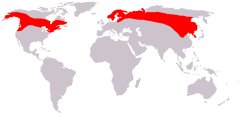 The moose (Alces alces) lives on the Northern hemisphere in forested areas, from Alaska, Canada in North America and from Finland to Eastern Russia and China (see range map below). Moose are the largest species of deer and may stand as tall as 2.3 meters high. Male moose antlers can grow up to 2 meters from tip to tip. They drop their antlers after each mating season. The antlers will grow back on in spring, which takes 3 to 5 months. Moose can reach speeds of up to 53 kilometers per hour, have poor eyesight, but excellent hearing. Moose are not endangered, but in some areas there has been a decline due to habitat destruction and hunting. Predators of the moose are wolves, grizzly bears, black bears and humans.
The moose (Alces alces) lives on the Northern hemisphere in forested areas, from Alaska, Canada in North America and from Finland to Eastern Russia and China (see range map below). Moose are the largest species of deer and may stand as tall as 2.3 meters high. Male moose antlers can grow up to 2 meters from tip to tip. They drop their antlers after each mating season. The antlers will grow back on in spring, which takes 3 to 5 months. Moose can reach speeds of up to 53 kilometers per hour, have poor eyesight, but excellent hearing. Moose are not endangered, but in some areas there has been a decline due to habitat destruction and hunting. Predators of the moose are wolves, grizzly bears, black bears and humans. Interesting fact: The name 'moose' means 'twig eater' in several languages spoken by indigenous peoples of the Americas.
Range map

Range map by Jrockley, licensed under GFDL
Image by Greg Marton, licensed under Attribution ShareAlike License v. 2.5
The European elk, moose is listed as Least Concern (LR/lc), lowest risk. Does not qualify for a more at risk category. Widespread and abundant taxa are included in this category, on the IUCN Red List of Threatened Species
Namings for the moose
A young / baby of a moose is called a 'calf'. The females are called 'cow' and males 'bull'.Countries
Austria, Belarus, Canada, China, Czech Republic, Estonia, Finland, Georgia, Kazakhstan, Latvia, Lithuania, Mongolia, Norway, Poland, Romania, Russia, Slovakia, Sweden, Ukraine and United StatesMoose habitats
Subarctic forestSome facts about the
Moose
Adult weight : 386 kg (849.2 lbs)
Female maturity :751 days
Male maturity : 612 days
Gestation : 243 days
Weaning : 100 days
Litter size : 1
Litters per year : 1
Interval between litters : 365 days
Weight at birth : 12.844 kg (28.2568 lbs)
Weight at weaning : 94 kg (206.8 lbs)
Basal metabolic rate : 287 W
Body mass : 325 kg (715 lbs)
Temperature : 38.85 °C (101.93 °F)
